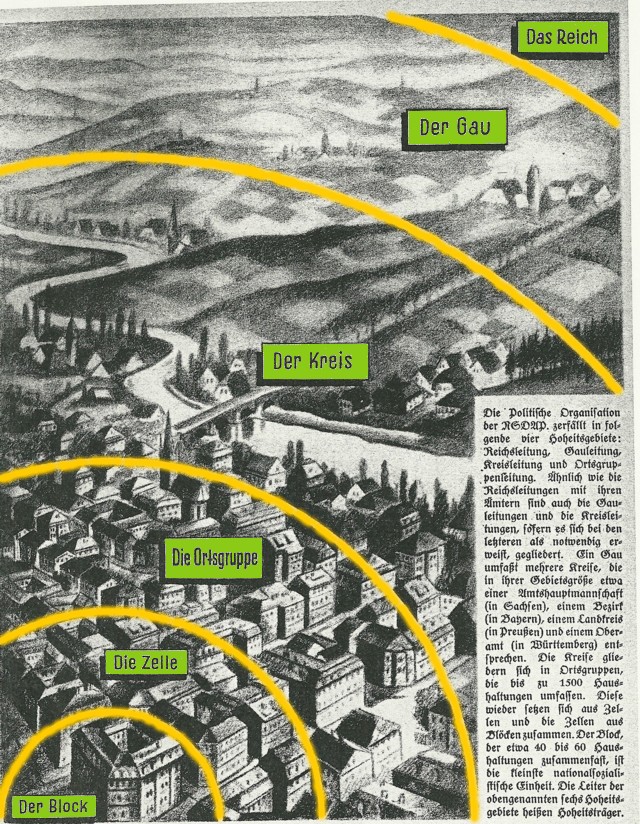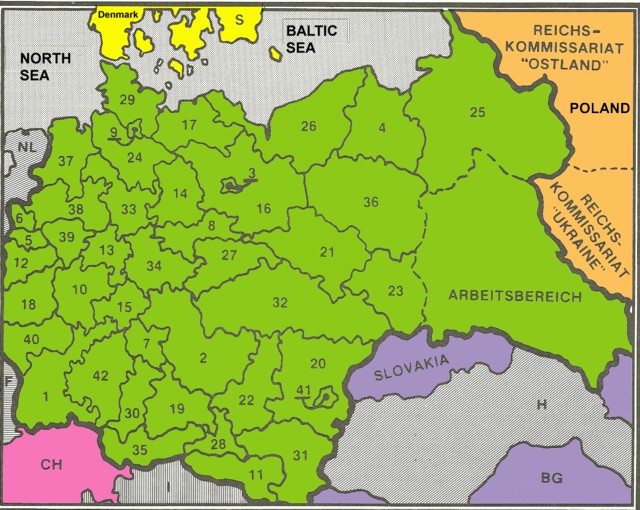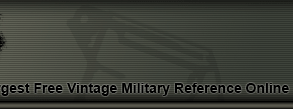|
|
GERMAN MILITARY AND CIVILIAN ORGANIZATIONS OF WWII
|
The Third Reich developed a large number of organizations to secure power and run the
country. Among them were the military groups that caused havoc all over Europe. There
was also a large security representation, which helped maintain order and oppressed
dissension throughout the country. Civilian groups were created to run public and
social services.
The following is a list of some of the military and civilian organizations that served
under Hitler's Germany in World War Two.
This information is provided free of charge to the visitor/enthusiast courtesy of
MilitaryItems.com ,
a company dedicated to the preservation of military history and to providing quality
military antiques and collectibles to museums, institutions and the general public.
|
|
MILITARY ORGANIZATIONS
|
 LUFTWAFFE (Air Force) LUFTWAFFE (Air Force) |
|
The official name for two of the four historic German air forces, the Wehrmacht air
arm founded in 1933 and disbanded in 1946.
|
|
 HEER (Army) HEER (Army) |
|
This is the name for the German Army. The Army was made part of the Wehrmacht in May 1935.
Between 1935 and 1945 this force grew to consist of hundreds of divisions and thousands of
smaller supporting units. Between 1939 and 1945 close to 16 million served in the Army.
|
|
 KRIEGSMARINE (Navy) KRIEGSMARINE (Navy) |
|
The Kriegsmarine was the name of the German Navy between 1935 and 1945, during the Nazi
regime, superseding the Reichsmarine, and the Kaiserliche Marine of World War I. The
Kriegsmarine was one of three official branches of the Wehrmacht.
|
|
 SS SS |
|
The SS was a major Nazi organization under Adolf Hitler and the Nazi Party. The SS grew
from a small paramilitary unit to a powerful force that served as the Führer's "Praetorian
Guard".
|
|
 WAFFEN SS WAFFEN SS |
|
The Waffen-SS were elite frontline combat troops trained to fight in Germany's battles
during WWII. The Waffen SS took part in some of the most ferocious engagements of the war.
In 1941 Himmler announced that additional Waffen-SS Freiwilligen units would be raised
from non-German foreign nationals. These were known as foreign volunteers.
|
|
CIVILIAN ORGANIZATIONS
|
 DLV DLV |
|
The Deutsche Luftsport Verband or DLV was the formation of the clandestine Luftwaffe.
The English translation is German Airsports Club. After the end of WWI, Germany was
forbidden to develop much of an air force. By creating the DLV they were able to train
pilots and keep then abreast of new technology. As Hitler's influence grew this
organization was converted into the NSFK.
|
|
 NSFK NSFK |
|
The National Socialistische Fliegekorps or NSFK came into existance in April 7th 1937.
It was formed from the DLV. The NSFK was controlled by the NSDAP. It's mission
continued to be the furthering of aviation for the Third Reich.
Its membership was voluntary and exclusive. Members were foridden to belong to other
organizations other than SA, SS or NSKK.
|
|
 HITLER YOUTH HITLER YOUTH |
|
The Hitler Youth, abbreviated HJ, was a paramilitary organization of the Nazi Party.
It existed from 1922 to 1945. The HJ was the second oldest paramilitary Nazi group,
founded one year after its adult counterpart, the Sturmabteilung (SA).
|
|
 NSDAP NSDAP |
|
The Nationa Sozialistische Deutsche Arbeiter Partei was founded in 1919.
Known as the Nazi party. Became the center of power and control in Germany
under Hitler's direction.
|
|
 NSKK (The National Socialist motor Corps) NSKK (The National Socialist motor Corps) |
|
It was established as a separate group of the SA in 1929. It originated from several motor groups of the SA and NSDAP
in the 1920's. Even though it was a separate organization it remained very close to the SA, even mimiquin its
structure.
|
|
 RLB RLB |
|
This is the National Air Defense League. Enacted on April 29th 1933.
Its mission was to develop civil defense forces among the population.
|
|
 RAD RAD |
|
This is the State Labor Service. The original mission was to perform public
works. As the war progressed this organization became a back up to the
army. As of June of 1935, all males of ages between 18 and 25 are required
to perform six months service.
|
|
 Deutsche Reichsbahn
Deutsche Reichsbahn
|
|
the Deutsche Reichsbahn The , "German Imperial Railway", was the name of the German national railway created
from the railways of the individual states of the German Empire following the end of World War I.
It was founded in 1920 as the Deutsche Reichseisenbahnen when the Weimar Republic, formally Deutsches Reich
("German Empire" – hence the usage of "Reich" in the name of the railway), took national control of the German
railways, which had previously been run by the German states.
|
|
 DRK (RED CROSS) DRK (RED CROSS) |
|
The German Red Cross was recognized in accordance with the agreement of Geneva dated
July 27th 1929. The first formal uniforms were established on August 6th 1935.
|
|
 SA SA |
|
The SA functioned as a paramilitary organization of the Nazi Party. It played a key role
in Adolf Hitler's rise to power in the 1920s and 1930s. Often called "brownshirts" for the
colour of their uniforms; this distinguished them from the Schutzstaffel (SS).
|
|
 TENO TENO |
|
The Technical Emergency Assistance (Technische Nothife), Known as TENO
was created in September 1919 by officers of the army's engineering
branch. Its purpose was to maintain essential social services in the
face of social disorder. They were a key organization in keeping gas,
water, electricity and railroad service during the allied air attacks.
|
|
DISTRICT AND GROUP ORGANIZATION (1939)
|
|
The Third Reich, under the control of Hitler and his planners, developed a system to divide the greater German
Reich into geographical regions. Creating the divisions and sub-division and requiring
identification paperwork
to move from area to area allowed the government to maintain and exercised better control of the general population,
factories and resources.
The following diagram shows the basic radius concept used to create the various groups.

Where the definitions of how the greater German Reich was divided are defined as follows:
| REICH | = | Reich (Total unit) |
| GAU | = | Administrative District (Total of 42) |
| KREISE | = | Area (total of 920) |
| ORTSGRUPPEN | = | Localities |
| ZELLEN | = | Cells |
| BLOCKE | = | City block |
The folloowing map outlines the location of the 42 GAUE. Some of the GAUE cover territory fromCzechoslovakia, Poland
and the Soviet Union. The data shown here applies to the year of 1939.

The granularity of the divisions employed by the Third Reich were an astonishing accomplishment for 1939.
Looking at the map and the explanation of the divisions and subdivisions makes it easier to understand how
Hitler was able to exert such total control over the population.
| Num |
GAU |
Headquarters City |
# of Blocke |
# of Zellen |
# of Orts-gruppen |
#of Kreise |
| 1 |
Baden |
Karlsruhe |
15,435 |
3,265 |
1.165 |
27 |
| 2 |
Bayreuth |
Bayreuth |
14,010 |
2,733 |
1,676 |
41 |
| 3 |
Berlin |
Berlin |
33,280 |
5,105 |
306 |
10 |
| 4 |
Danzig-Westpreuben |
Danzig |
10,153 |
3,022 |
503 |
31 |
| 5 |
Dusseldorf |
Dusseldorf |
16,989 |
2,699 |
216 |
7 |
| 6 |
Essen |
Essen |
11,044 |
2,090 |
180 |
0 |
| 7 |
Franken |
Nurnberg |
5,868 |
1,156 |
311 |
11 |
| 8 |
Halle-Merseburg |
Halle (saale) |
10,670 |
2,390 |
685 |
17 |
| 9 |
Hamburg |
Hamburg |
11,293 |
1,676 |
160 |
10 |
| 10 |
Hessen-Nassau |
Frankfurt (main) |
17,896 |
3,247 |
1,352 |
26 |
| 11 |
Karnten |
Klagenfurt |
3,728 |
945 |
242 |
8 |
| 12 |
Koln-Aachen |
Koln |
15,086 |
3,351 |
434 |
20 |
| 13 |
Kurhessen |
Kassel |
5,797 |
1,322 |
344 |
15 |
| 14 |
Magdeburg-Anhalt |
Dessau |
11,800 |
2,441 |
747 |
18 |
| 15 |
Mainfranken |
Wurzburg |
4,497 |
1,067 |
322 |
14 |
| 16 |
Mark Brandenburg |
Berlin |
18,003 |
3,315 |
1,730 |
30 |
| 17 |
Mecklenburg |
Schwerin |
8,008 |
1,468 |
627 |
13 |
| 18 |
Moselland |
Koblenz |
7,632 |
1,510 |
735 |
18 |
| 19 |
Munchen-Oberbayern |
Munchen |
13,621 |
1,776 |
616 |
23 |
| 20 |
Niederdonou |
Wien |
15,491 |
3,213 |
794 |
26 |
| 21 |
Niederschlesien |
Breslau |
21,734 |
4,806 |
1,299 |
35 |
| 22 |
Oberdonau |
Linz (z.ZT.Wien) |
9,424 |
2,250 |
481 |
17 |
| 23 |
Oberschlesien |
Kattowitz |
17,067 |
3,885 |
922 |
24 |
| 24 |
Ost-Hannover |
Luneburg |
6,486 |
1,513 |
478 |
16 |
| 25 |
Ostpreuben |
Konigsberg |
14,230 |
3,284 |
643 |
45 |
| 26 |
Pommern |
Slettin |
14,196 |
3,288 |
1,033 |
31 |
| 27 |
Sachsen |
Dresden |
36,351 |
7,207 |
1,492 |
27 |
| 28 |
Salzburg |
Salzburg |
2,539 |
635 |
123 |
5 |
| 29 |
Schleswig-Holstein |
Kiel |
11,752 |
2,520 |
802 |
21 |
| 30 |
Schwaben |
Augsburg |
5,093 |
779 |
630 |
15 |
| 31 |
Steiermark |
Graz |
7,050 |
1,557 |
343 |
17 |
| 32 |
Sudelenland |
Reichenberg |
23,942 |
4,797 |
1,821 |
45 |
| 33 |
Sud-Hannover-Braunschweig |
Hannover |
13,910 |
2,969 |
903 |
26 |
| 34 |
Thuringen |
Weimar |
14,154 |
2,557 |
1,455 |
20 |
| 35 |
Tirol-Vorarlberg |
Innsbruck |
4,821 |
813 |
335 |
10 |
| 36 |
Wartheland |
Posen |
10,299 |
2,401 |
501 |
41 |
| 37 |
Weser-Ems |
Oldenburg |
12,624 |
2,679 |
609 |
13 |
| 38 |
Westfalen-Nord |
Munster |
17,725 |
3,331 |
908 |
19 |
| 39 |
Westfalen-Sud |
Bochum |
15,856 |
3,113 |
627 |
18 |
| 40 |
Westmark |
Neustadt |
10,010 |
2,213 |
529 |
18 |
| 41 |
Wien |
Wien |
14,501 |
2,391 |
315 |
10 |
| 42 |
Wurttemberg-Hohenzollern |
Stuttgart |
16,748 |
3,579 |
1,187 |
35 |
| 43 |
Auslandsorganisation |
Berlin |
n/a |
n/a |
n/a |
n/a |
|
|
|
This information is brought to you courtesy of
MilitaryItems.com . The premiere
provider of military collectibles to the education sector, museums and the private enthusiast.
|
|





